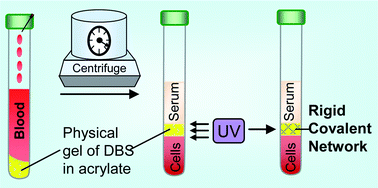Current gels used in blood separation tubes create an imperfect barrier between the blood components because of their physical and thixotropic nature. As a result, blood components tend to leak into the gel layer or vice versa during transport and storage. To overcome these problems, we demonstrate the use of a UV-curable thixotropic gel composed of a sorbitol-based gelator in a diacrylate oligomer. Initially, the sample is a physical gel composed of weak, non-covalent bonds, and its thixotropic nature allows it to flow under centrifugation and form a barrier between the density-stratified layers of blood. Immediately afterward, the gel is chemically crosslinked by short exposure to UV light for 10–30 s. This results in a rigid, impenetrable barrier that is freeze-thaw stable. The gel is compatible with blood, allowing blood samples to be stored in the tube and analyzed over long times. We believe the present method is a significant advance in the practice of blood analysis for medical purposes.

You have access to this article
 Please wait while we load your content...
Something went wrong. Try again?
Please wait while we load your content...
Something went wrong. Try again?


 Please wait while we load your content...
Please wait while we load your content...